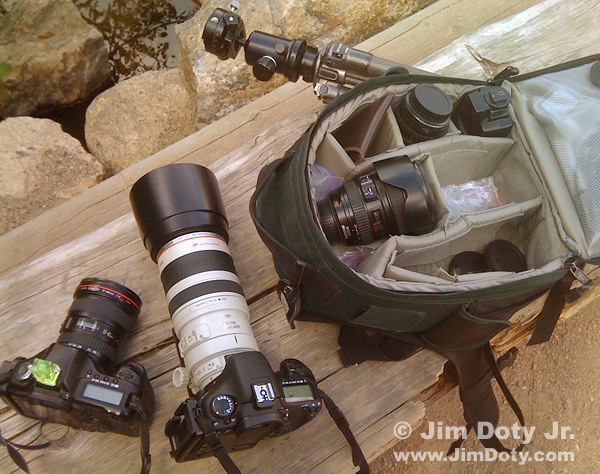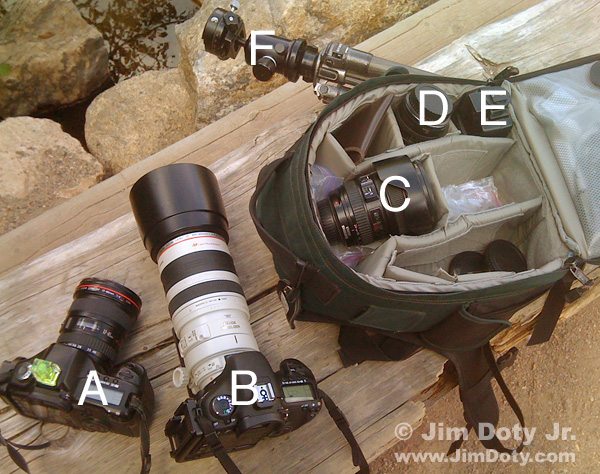Traveling by plane severely limits the amount of camera equipment you can take with you. As lots of photographers will attest, take everything with you as carry-on gear, NOT in your checked luggage. The airlines will NOT reimburse you for lost or damaged photographic equipment (see my comments toward the end of this article). If your checked luggage goes astray, everything you need should be with you in your carry-on luggage. And you need a backup plan in case something quits working.
Essential Gear
Most of my essential gear for a photography trip fits in a Lowepro Micro Trekker 200 backpack. Although it is a small backpack, it holds more than you would expect: 2 camera bodies, 4 lenses, a flash unit, plus accessories. During a shooting break at Bear Lake (Rocky Mountain National Park), I took out my iPhone and grabbed a snapshot of my gear on a log bench (above). This is what goes in the backpack for a nature photography trip:
Canon 5D camera
Canon 7D camera
Canon 15mm fisheye lens
Canon 17-40mm lens
Canon 24-105mm lens
Canon 100-400mm lens
Canon 550 EX flash
Accessories
In addition to what’s in the backpack, I also carry a Gitzo Mountaineer tripod with a Kirk enterprises ball head. That gives me everything that is essential for nature, landscape, and wildlife photography. If I’m doing people photography, or if I’m doing landscape photography but not doing wildlife photography, I substitute a Canon 70-200mm zoom for the 100-400mm zoom.
Getting on the Plane as Carry-on Gear
To get on the plane, the backpack, tripod and ball head go inside a standard, carry-on sized, “roller bag” suitcase. My tripod is one of the few “full sized” tripods that will fit in a carry-on bag once the head has been removed. That still leaves some extra room in the roller bag for an extra Canon flash unit, a Canon S3 IS point & shoot camera, incident light meter, sometimes an extra lens, plus whatever other extra accessories I might want to have with me. The roller bag doesn’t look like camera gear, and it never leaves my sight. It makes for a well packed carry-on. On some flights, TSA asks me to open the roller bag and the backpack so they can look inside.
I also carry on a laptop case with laptop and other goodies. That keeps me carry-on legal with just the roller bag and laptop case to carry on to the plane. I also wear an empty photographer’s vest. If some official decides my carry-on is too heavy, I can load gear into the pockets of my vest (it will hold one bodies and 3 or 4 lenses) to bring down the weight of the carry-on. I haven’t needed to do that, but some other photographers have had to transfer gear to a vest to get everything on to the plane with them.
My clothes go into one piece of checked luggage. If it gets lost, I can always buy a few clothes at my destination. So far, that hasn’t happened. Camera gear, on the other hand, is not easily replaceable at the destination. Sometimes it very hard to find a camera shop at your destination that can rent the equipment that you need, and renting locally can be pricey. Buying new replacement gear at your destination can be very expensive, and it is unlikely they will have what you want as used gear (buying used gear from a reputable dealer with a good warranty and a reasonable return period is a good way to hold down equipment costs).
What you see in the photo above is what I carry with me when I am out shooting in the landscape. Captions are at the end of this post. Not pictured is the photo vest I weat with an incident light meter, filters, and other small accessories. The spare flash, Canon S3 IS and other backup gear are in the trunk of the rental car, ready to go if needed, but I don’t carry them with me when I am out shooting.
Overlap and Backup
I picked my gear to give me as much overlap and backup as possible, given the limitations of airline travel. If any one piece of equipment quits working, I can still do most of what I want to do.
Two bodies are essential. If one quits, I still have one to use. But there are other advantages to having two bodies.
When I am doing landscape work with a 17-40mm or 24-105mm lens on the 5D, I often have the 100-400mm lens on the 7D for fleeting wildlife opportunities. There are times when taking time to change lenses will cost you the shot. During my break at Bear Lake (when the above photo was taken), a Gray Jay showed up just a few feet from the log bench with my gear. I would have missed the photo below if the 100-400mm lens wasn’t already on my Canon 7D. The focal length was 400mm (400mm on a 7D is equivalent to 640mm on a full frame digital camera or a 35mm film camera). With the 40mm focal length that was on the Canon 5D at the time, this jay would have been only 1/16 as big, just a small blip in the photo.
Thanks to the field of view crop of the Canon 7D, the effective apparent focal length of all my lenses is 60% longer. This also give me extra overlap if a lens happens to quit working. The 17-40mm lens becomes 27-64mm. The 24-105mm becomes 38-168mm and the 100-400mm becomes 160-640mm. The 15mm fisheye becomes a 24mm lens but straight lines look bowed if they don’t go right through the middle of the frame.
If the 15mm fisheye lens dies (my least used lens), I still have everything from 17mm to 640mm covered. If the 17-40m goes belly up, I still have the fisheye and everything from 24 to 640mm. If the 24-105mm refuses to work, I still have 17 to 64mm and 100 to 640mm covered, which is still very good. The gap from 64 to 100mm won’t matter too much.
Losing the 100-400mm lens would hurt the most. I would have everything from 17 to 168mm plus the fisheye. Fine for everything but wildlife. That’s why I bring the Canon S3 IS which has a very long zoom range (36-432mm). It obviously doesn’t have the image quality of a DSLR which can produce files for prints up to 20×30 inches, but the S3 can easily produce files which can make nice 8×10 or larger prints. Depending on what I am shooting and the other accessories I put in my roller bag, I may pack the very compact Canon EF 70-300 f/4.5-5.6 DO IS lens as a backup to the 100-400mm zoom.
If the Canon 7D gives up the ghost, I lose the 400-640mm focal length it gives me with the 100-400mm lens, but I still have 17 to 400mm plus the fish eye lens so I am still in great shape.
If I lose the Canon 5D, The Canon 7D will give me the equivalent of about 24mm with the fisheye lens (with some bowing of straight lines in the photos), and I will have the equivalent of 27 to 640mm with the other three lenses. I would really miss the 17 to 27mm wide angle focal lengths for landscapes, but I would get by. The “24mm” fisheye would do in a pinch when I can disguise the fisheye effect in the landscape.
As long as I don’t lose more than one piece of equipment on a trip, I am in pretty good shape.  If I lose 2 lenses, I could be seriously hurting. Another reason for the Canon S3 IS that I carry in the trunk of the rental car, just in case. In the unlikely event both DLSRs decided to take a vacation from working, the Canon S3 IS would be my only option.
Shipping Your Gear
If it is a once in a lifetime trip and the above limitations won’t provide as much gear as you want to have with you, you can always FedEx your backup gear to meet you at your destination. I did that for a trip to Alaska. I carried my usual gear on the plane, and I shipped another backpack, with camera body and several more lenses to the FedEx office in Anchorage. On my way back to the airport at the end of the trip, I stopped at FedEx to ship my backup gear back home. It was a once in a lifetime trip and I wanted to be ready, no matter what happened.
Equipment Failure Rate
How often does gear quit? That depends. In 26 plus years of almost daily shooting, I’ve had 2 camera bodies and one lens malfunction so that they weren’t were fixable in the field. (I have had several minor incidents in which a camera or lens had problems but they could be revived in the field.) Gear fails more often under adverse conditions. I read about a group of photographer on a trip to Antarctica and many of the photographers had one of more pieces of gear quit out in the cold. Some of the gear recovered back in the warmth of the ship, and some didn’t.
Traveling by Car
If I am traveling by car, everything changes. I take all of the above gear, plus a third SLR camera body, another telephoto zoom lens, two or three prime (non-zoom) lenses and whatever else I want to have with me.
Backup gear for any trip is important, even if it is a small, point and shoot camera.
Stolen Gear from Checked Luggage
Now for a few comments about camera gear stolen from checked luggage. It happens. The internet is filled with stories of people who had camera gear stolen out of their checked luggage even though their luggage arrived (here’s one of my favorites). Don’t expect the airlines to reimburse you for the value of expensive camera gear. Airlines specifically exclude camera gear from their reimbursement policy for lost luggage. If your camera gear is lost or stolen, you will not receive a penny from the airlines.
I think most people are honest (including baggage handlers), but I’ve read too many unhappy stories to feel comfortable checking any expensive and/or essential gear. I’ve put umbrellas (for my flashes) and other inexpensive items in my checked luggage, but never my cameras and lenses. One unhappy professional put some of his expensive gear in a hard sided, foam filled camera case and sent it through with the rest of his checked luggage. Later he was sitting on the plane, looked out the window, and saw his hard sided camera case waiting to be loaded onto the plane. Then he watched a brazen baggage handler take his case and walk away with it.
I am aware of this clever suggestion to check your camera gear in a locked case with a gun, but I would just as soon have my camera gear with me.
Photo Gear Captions
A. Canon 5D with double bubble level, Canon EF 17-40mm f/4L wide angle zoom lens with Singh-Ray polarizing filter,
B. Canon 7D, Canon EF 100-400mm f/4-5.6L IS (image stabilized) telephoto zoom lens (with lens hood).
C. Canon EF 24-105mm f/4L IS (image stabilized) zoom lens (with reversed lens hood).
D. Canon EF 15mm fisheye lens stacked on top of a 25mm extension tube (not visible).
E. Canon 550 EX Speedlite flash unit.
F. Gitzo Mountaineer G1228MK2 carbon fiber tripod with Kirk enterprises BH-3 ball head.
Lowepro Micro Trekker 200 backpack.
Not pictured: Photo vest and accessories.
Purchase Link
You can check out (and buy) most of this gear in the Canon section at my new photography store (powered by Amazon.com).



